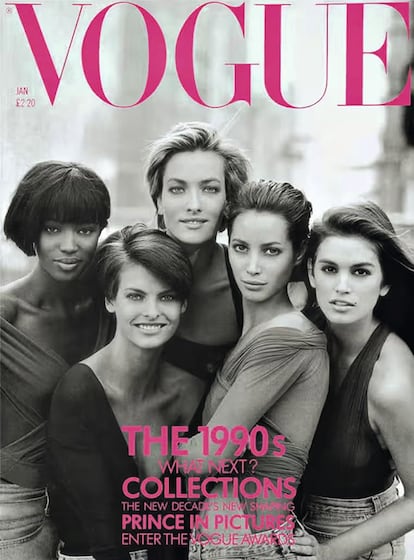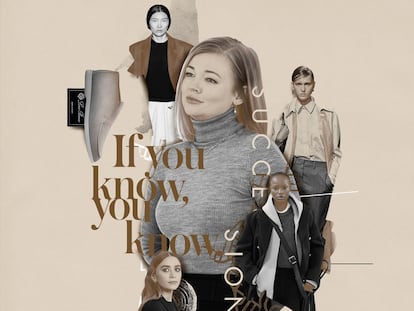‘Vogue’ cover: Wrinkles, Photoshop and lack of imagination
Naomi Campbell, Cindy Crawford, Linda Evangelista and Christy Turlington, who are all over 50, are so heavily retouched that the image is almost comical

Despite my admiration for the four women who appear on the cover of the September issue of Vogue — traditionally the most emblematic of the year —, it is difficult not to support the wave of criticism that the photo has triggered. The latest edition of Vogue features Naomi Campbell, 53, Cindy Crawford, 57, Linda Evangelista, 58, and Christy Turlington, 54, the supermodels of the 1990s, who changed the course of fashion history. These models were pop culture icons, and their story is the focus of a new four-part Apple TV+ series, The Super Models, which premieres on September 20. In honor of the new series, the four models were reunited for a photo for the front cover of Vogue — an image which has since been roundly condemned on social media.
The cover has been called “toxic,” “disheartening,” “regrettable” and even “grotesque” for showing the models — who are all over the age of 50 — with excessively smooth faces in a photo that has been so heavily retouched it is almost laughable. At least two of the models — Turlington and Crawford — look infinitely better on their Instagram accounts. Indeed, the photo brushes away the individuality of a generation of models that burst onto the scene in the 1990s. The four made waves when they appeared together on the cover of the now-legendary January 1990 cover shot by Peter Lindbergh, who consecrated them as muses of a new beauty as unattainable as it was brimming with truth.
Time has not treated them all equally, and perhaps that’s what explains the nonsensical Vogue cover. Campbell, with her privileged genetics and clinical touch-ups, appears to be frozen with the same feline expression. The case of Evangelista is more striking. In 2021, she revealed that she had decided to live away from the public spotlight after suffering a serious problem with a liposculpture procedure that had left her “brutally disfigured.” The next year, she spoke more about her struggle in a Vogue article, where she was photographed by Steven Meisel. Since then, it has been impossible to dissociate her from an artifice of dramatic overtones.
I imagine that photographing four women who have aged in such different ways was a complex task, and the two who look the best at their age, Turlington and Crawford, lost out in the facial sweep.
The cover of Vogue was shot by a rising star of fashion photography, Brazilian artist Rafael Pavarotti. It comes just after Zara named 67-year-old Spanish actress Angela Molina as the face of their latest campaign. This choice was widely applauded, even though Molina has long been embracing her gray hair and wrinkles as a fashion icon for photographers such as Nico and Gorka Postigo; avant-garde designers like Gabriela Coll and mainstream brands like Hoss Intropia. Despite this, Zara’s campaign was celebrated by women’s magazines and the general media with great fanfare. The press repeated the same mantra of marketing activism, in this case the Spanish brand’s stance against so-called “ageism,” and ignored the fact that the powerful company showed very little originality.
Despite the differences between the two campaigns, there is not that much that separates the pathetic Photoshopping of the Vogue cover from Zara’s advertising with a message. It’s all part of the same worrying trend: the lack of imagination that has lately characterized the fashion industry.
Sign up for our weekly newsletter to get more English-language news coverage from EL PAÍS USA Edition
Tu suscripción se está usando en otro dispositivo
¿Quieres añadir otro usuario a tu suscripción?
Si continúas leyendo en este dispositivo, no se podrá leer en el otro.
FlechaTu suscripción se está usando en otro dispositivo y solo puedes acceder a EL PAÍS desde un dispositivo a la vez.
Si quieres compartir tu cuenta, cambia tu suscripción a la modalidad Premium, así podrás añadir otro usuario. Cada uno accederá con su propia cuenta de email, lo que os permitirá personalizar vuestra experiencia en EL PAÍS.
¿Tienes una suscripción de empresa? Accede aquí para contratar más cuentas.
En el caso de no saber quién está usando tu cuenta, te recomendamos cambiar tu contraseña aquí.
Si decides continuar compartiendo tu cuenta, este mensaje se mostrará en tu dispositivo y en el de la otra persona que está usando tu cuenta de forma indefinida, afectando a tu experiencia de lectura. Puedes consultar aquí los términos y condiciones de la suscripción digital.
More information
Archived In
Últimas noticias
Most viewed
- Oona Chaplin: ‘I told James Cameron that I was living in a treehouse and starting a permaculture project with a friend’
- Reinhard Genzel, Nobel laureate in physics: ‘One-minute videos will never give you the truth’
- Sinaloa Cartel war is taking its toll on Los Chapitos
- Why the price of coffee has skyrocketed: from Brazilian plantations to specialty coffee houses
- Silver prices are going crazy: This is what’s fueling the rally











































